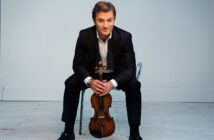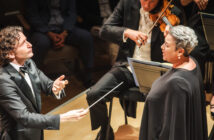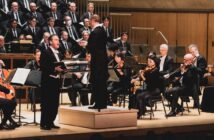by Paul E. Robinson
My first encounter with Tchaikovsky’s Manfred Symphony was most likely Toscanini’s 1953 recording with the NBC Symphony; it is intense, exciting and almost life-changing in its range of emotion. The sound of the recording left a lot to be desired, of course, but for its time, this was a great performance.
Over the years, although I rarely encountered Manfred in the concert hall, I continued to check out fresh performances and new recordings; unfortunately, not one of them could hold a candle to the Toscanini – until, that is, now.
This extraordinary performance was live, and I may have to wait a little longer for the recording, but the Manfred I heard at the Meyerson Symphony Center in Dallas, Texas last week not only rivaled the Toscanini in excellence – it may, in fact, have surpassed it!
Jaap van Zweden has long since shown himself to be an exceptionally gifted Tchaikovsky interpreter. Live performances of the Fourth and Fifth symphonies have already been released by the Dallas Symphony and they are remarkable for their exceptional standard of playing and commitment.
Manfred Symphony Difficult and Flawed
In Manfred, van Zweden has taken one of Tchaikovsky’s less popular works and raised it to the status it has always deserved as one of the composer’s most inspired and deeply personal compositions.
This is a difficult piece to play, and it has its weaknesses, but van Zweden has incomparable skills as an orchestra builder. In less than two seasons he has transformed a ‘very good’ Dallas Symphony into one of the finest orchestras in the country. Difficulties take only a little longer to surmount with van Zweden on the podium. There is never any doubt that he will get his musicians where they need to be, and so it was with Manfred.
The maestro’s tempi were sometimes very fast indeed – but they always made perfect sense – and the DSO players were equal to every challenge. The horn section, led by Gregory Hustis and David Heyde, had a particularly fine night with robust playing and a golden sonority, rivaling the best in the business.
And Manfred’s weaknesses?
One could begin with the stop-start feeling one often gets when the piece is performed; it can sound like Russian Bruckner, if such a thing can be imagined. Then there is the meretricious character of the theme introduced at bar 81 in the last movement, and a fugue that can sound pedantic and unconvincing.
Worst of all, in the opinion of some listeners, is the final section depicting the death of Manfred and, presumably, his ascent to heaven with the help of an organ introduced for the first time in the symphony. After this fortissimo apotheosis comes a very weak winding down over several pages to the end of the score. By all accounts, Tchaikovsky himself was not satisfied with the ending of Manfred; in fact, on one particularly depressing day, he declared in a letter that nothing in the piece, with the exception of the first movement, was of any value!
DSO/van Zweden Reading Puts Manfred Back in Play
Weaknesses there may be in Manfred, but most of them ceased to exist in van Zweden’s remarkable reading.
How did he do it?
Generally speaking, he did it by simply understanding the shape and substance of the piece and working assiduously with his orchestra to translate that understanding into sound. Specifically, he eliminated the alleged fragmentation of the piece by making sure every phrase had life and destination. That is to say, the music was always going somewhere and pulsed with inner life. This magic doesn’t just happen by itself; it requires the conductor to meticulously work out every slight alteration in tempo and every minute change in dynamics.
Van Zweden is a great conductor, partly through sheer force of personality, but also because he takes the trouble to understand every detail of the music he conducts and then to convey that understanding to his players.
Another “weakness” that disappeared in this performance was the triteness of the D minor theme in the finale. By taking a very fast tempo, thereby eliciting ferocious playing from his musicians – the tempo marking is Allegro con fuoco – this tune became suitably menacing, in the manner of similar tunes in the last movement of Berlioz’ Symphonie Fantastique.
What about the organ apotheosis and its underwhelming aftermath? We may never know what van Zweden might have done to find greatness in these bars because he simply threw them out! In fact, he substituted a different ending altogether – an ending borrowed from the legendary Russian conductor Evgeny Svetlanov. Still Tchaikovsky’s music, this ending, taken from the first movement of Manfred, works perfectly and brings the symphony to a much more powerful conclusion.
It would be foolish to dwell on the alleged weaknesses of Manfred when the work has so many strengths and so much beauty. The very first sounds in the symphony are a case in point. I defy anyone who is hearing the piece for the first time to identify the instruments playing here. In fact, Tchaikovsky has created the most hauntingly beautiful sound for these mournful opening bars by scoring three bassoons and bass clarinet in unison. They play their melody together for fully the first 14 bars.
What about the doleful but thrilling tutti in the Andante con duolo* section in the first movement? Van Zweden achieved an incredibly rich string sonority at this point. What gives this passage much of its power is the scoring involving trombones, tuba and timpani along with the strings, added to the driving syncopated figure played by the lower winds.
The second movement Scherzo outdoes Mendelssohn’s Midsummer Night’s Dream and Berlioz’ Queen Mab in its magical evocation of fairies. The instrumentation is, again, highly original and the rhythms complex and unorthodox. The Trio section, with its meltingly beautiful violin melody accompanied by two harps, is exquisite. At the very end of the movement, Tchaikovsky divides the violins into five parts to raise the magic another notch. The DSO violins were wonderfully delicate and precise in this difficult section. New associate concertmaster Nathan Olson topped off the wizardry with seemingly effortless execution of the solo passage ending the movement.
There is greatness in this symphony, but it takes a conductor who believes wholeheartedly in the piece and who has the energy and expertise to bring it out. Van Zweden is such a conductor and with the Dallas Symphony at the top of its game, the music soared.
Glamour, Technique and a Too Cool Kern
In the first half of this all-Tchaikovsky programme Olga Kern was the soloist in the Piano Concerto No. 1.
Ms. Kern has become a favourite in these parts after winning the Cliburn Competition in Ft. Worth in 2001. As a Russian-born and Russian-trained pianist, she might be assumed to have an affinity for this music. There is no doubt that she has extraordinary technique. but her performance on this night was curiously restrained; one had the impression that she was trying to intellectualize the music. The result was slow tempi and rumination over material that didn’t warrant it.
Ms. Kern also gave the regrettable impression that she was not much interested in the orchestra’s contribution to the performance. She seemed never to acknowledge important orchestra solos – flute and oboe principals deserved better than that – and played her accompanying figures much too loudly over the winds’ melodic lines. Van Zweden and the DSO did their best to interact with their glamorous soloist; unfortunately, it was mostly a one-sided conversation.
For Those Wanting More…
It’s always a delight to visit Dallas and its ever-expanding Arts District. The Dallas Museum of Art is world class and nearby are the Nasher Sculpture Garden and the Trammel Crowe Museum of Asian Art. From these facilities, it’s a short walk to the Myerson – did I mention that it’s one of the world’s great concert halls? – and next door to the Myerson is the new Winspear Opera House. Across the street is the Dallas Theater Center, etc. Just a short drive down I-30 to Ft. Worth is another fine complex of museums and concert halls.
If your interests are wide enough to include major league sports, check out the Texas Rangers (baseball), the Dallas Cowboys (football), the Dallas Stars (hockey) and the Dallas Mavericks (basketball)?
Eating in fine restaurants is one of my favorite sports and Dallas provides endless opportunities to participate. Marita and I usually stop in at La Duni, but on this visit we only had time for Samar – try combining the cuisine of Spain, India and the Mediterranean – on Ross near the Arts District and for Lavendou, a wonderful old Provencal-inspired French bistro on Preston Rd.
*Andante con duolo is a very unusual tempo marking. It might be rendered in English as “Slow with grief”. This is the state of mind of the tormented Manfred of Byron’s poetic drama. This ill-fated man must try to live with the memory of his incestuous love for his sister Astarte. Music lovers may be aware of a similar relationship recounted in the Finnish epic poem Kalevala, set to music by Sibelius in his Kullervo Symphony.
Paul E. Robinson is the author of Herbert von Karajan: the Maestro as Superstar, and Sir Georg Solti: His Life and Music. NEW for friends: The Art of the Conductor podcast, “Classical Airs.”
DSO and van Zweden: A Persuasive “Manfred” in Dallas!
0
Share:














